- java.lang.Object
-
- com.openinventor.inventor.Inventor
-
- com.openinventor.inventor.misc.SoBase
-
- com.openinventor.inventor.fields.SoFieldContainer
-
- com.openinventor.inventor.nodes.SoNode
-
- com.openinventor.inventor.nodes.SoShaderProgram
-
- com.openinventor.volumeviz.nodes.SoVolumeShader
-
- com.openinventor.volumeviz.nodes.SoVolumeRenderingQuality
-
- All Implemented Interfaces:
- SafeDisposable
public class SoVolumeRenderingQuality extends SoVolumeShader
Volume rendering quality property mode. This property node causes subsequentSoVolumeRendernodes to be drawn with different rendering effects and/or levels of quality.NOTE:
- Only one (or none) of the following nodes can be active at a time:
SoVolumeShaderorSoVolumeRenderingQuality. However since Open Inventor 7.1, bothSoVolumeRenderingQualityandSoVolumeIsosurfacemay applied to the sameSoVolumeRendernode. - If the application simply needs to replace one or more of the VolumeViz shader rendering functions with a customized shader, you can use either
SoVolumeShaderorSoVolumeRenderingQuality. However if the application needs the advanced rendering features ofSoVolumeRenderingQuality, e.g. lighting, in addition to the customized behavior, then you should use this node (which is derived fromSoVolumeShader). Using the shader rendering framework is explained on theSoVolumeShaderpage. - The
SoVolumeRenderingQualitynode must be before theSoVolumeRenderand after theSoTransferFunction. - This is a shader node!
The effect will usually be undesirable if it is applied to standard geometry (polygons, lines, etc). Therefore applications should generally keep the volume visualization nodes and standard geometry nodes separate in the scene graph (i.e. under differentSoSeparatornodes). - Please read the comments for each field.
Some options have no effect in ray-casting mode (the default) and some options only apply in ray-casting mode. Similarly, some options only apply to gradient lighting and have no effect on deferred lighting.Pre-integrated and lighted rendering Various enhanced rendering modes for volume rendering are available:
- Pre-integrated volume rendering
- Lighted volume rendering
The pre-integrated mode (
preIntegratedfield) generally provides higher image quality for the same number of slices. Most applications should enable this field. However, note that pre-integration integrates between color map values. For typical scalar data containing sampled values, this provides a beneficial smoothing. It is especially useful when the color changes sharply between adjacent color map entries. However, when the color changes sharply between adjacent voxels, it can can cause values that are not actually in the original data to be displayed. This is undesireable for some data, for example "label" volumes resulting from segmentation. Pre-integration is not recommended for such data. Also note:- The
preIntegratedfield has no effect onSoVolumeIsosurfacerendering. - The
preIntegratedfield is only considered when SoVolumeRendering.renderMode is set to VOLUME_RENDERING (the default).
When lighting is enabled for volume rendering, VolumeViz applies the same lighting equation used for polygonal geometry, including (optionally) specular highlights. The base voxel color comes from the
SoTransferFunctionnode or (optionally) from a custom shader function provided by the application. This color is modified using the current material (SoMaterial), a vector simulating a "normal vector" and one or more directional light nodes (SoDirectionalLight) found in the scene graph. Voxels can also cast and receive shadows (seeSoShadowGroup).Limitation: Pre-integrated and lighted rendering are not supported if using custom fragment shaders and redefining FRAGMENT_COMPUTE_COLOR slot.
VolumeViz supports two lighting modes using either the
lightingfield or thedeferredLightingfield. In both cases lighting is computed on the GPU as part of the rendering process. (Do NOT use the lighting field in theSoVolumeRenderingnode. This field enables a CPU lighting computation that is slow.)- Gradient lighting
Thelightingfield enables gradient based lighting, where the "normal vector" at each sample along the ray is a gradient vector computed from the data values in the volume. Gradient based lighting only supports a single light source and only the first light in the scene graph (typically the viewer's "headlight") is used. No other lights affect the volume in this case. ThegradientQualityfield controls the algorithm used to compute gradient vectors. Several other fields affect the gradient computation includinggradientThreshold,surfaceScalarExponentandunnormalizedGradientExponent. Setting surfaceScalarExponent to a small value, for example 2.0, is recommended.
- Deferred lighting
ThedeferredLightingfield enables screen space lighting, where the "normal vector" is computed from the final image depth buffer. Deferred lighting is faster and supports multiple light sources, but works best when the transfer function makes each data value either opaque or transparent. Deferred lighting is not affected by gradient related fields.
Unlike other primitives (including other VolumeViz primitives), volume lighting is not affected by an
SoLightModelnode. Also unlike other primitives, if lighting is enabled and there are no light nodes in the scene graph, the voxel color is taken from the transfer function or custom shader function "as is" (other primitives would be black in this case).Each light node's direction and intensity fields are used, but the color field is not currently used. The current
SoMaterialspecifies the ambient, specular, diffuse, and emissive color values for the lighting equation. Note that the default diffuse color is "light gray" (0.8), not full white. This allows specular lighting to push the color toward full white (as expected). If specular lighting is not desired, then changing this to full white (1.0) is recommended in order to see the true colors specified in the transfer function.The following figures show the same volume data:
<TABLE border=1 cellspacing=0 cellpadding=5> <TR><TD valign=_top> Default volume rendering <TD valign=_top> Pre-integrated volume rendering <TD valign=_top> Lighted pre-integrated volume rendering <TR><TD valign=_top> @image html quality_volume.jpg <TD valign=_top> @image html quality_preintegrated.jpg <TD valign=_top> @image html quality_light.jpg </TABLE> Quality enhancement parameters Jittering: When
jitteringis set to true, a random offset is added to texture coordinates in order to decrease "ring" artifacts without the cost of drawing a higher number of slices. Note that this creates a "noisy" image. Instead we recommend setting theSoVolumeRender.samplingAlignmentfield to BOUNDARY_ALIGNED.<TABLE border=1 cellspacing=0 cellpadding=5> <TR><TD valign=_top> No Jittering <TD valign=_top> With Jittering <TR><TD valign=_top> @image html volume_nojitter.jpg <TD valign=_top> @image html volume_jitter.jpg </TABLE> Gradient quality: When gradient lighting (
lightingfield) is enabled, thegradientQualityfield allows you to choose between various gradient computation techniques. The computational cost increases with the quality. Has no effect on deferred lighting.<TABLE border=1 cellspacing=0 cellpadding=5> <TR><TD valign=_top> Low quality <TD valign=_top> Medium quality <TD valign=_top> High quality <TR><TD valign=_top> @image html volume_forwarddiff.jpg <TD valign=_top> @image html volume_centraldiff.jpg <TD valign=_top> @image html volume_sobel.jpg </TABLE> Surface scalar: When gradient lighting (
lightingfield) is enabled oredgeDetect2DMethodis GRADIENT, thesurfaceScalarExponentfield disables lighting (or edge detection) on uniform surfaces in order to avoid noise in these area. This field should not be mixed withunnormalizedGradientExponent. The default value is zero, but a small value, for example 2.0, is recommended. Has no effect on deferred lighting.<TABLE border=1 cellspacing=0 cellpadding=5> <TR><TD valign=_top> Surface Scalar disabled <TD valign=_top> Surface Scalar enabled <TR><TD valign=_top> @image html surfaceScalarOff.jpg <TD valign=_top> @image html surfaceScalarOn.jpg </TABLE> Unnormalized gradient : When gradient lighting (
lightingfield) is enabled, ifunnormalizedGradientExponentis not 0, voxels with small gradients will get more contribution from the ambient light than voxels with high gradients. It is similar tosurfaceScalarExponentbut uses the ambient light instead of the transfer function color for uniform surfaces. Has no effect on deferred lighting.Gradient threshold: When gradient lighting is enabled, gradients with a length less than
gradientThresholdare ignored during the lighting computation. This avoids doing lighting on noise while still lighting important data. In the following screenshots, setting a threshold of 0.1 removed lighting on the noise surrounding the spheres. Has no effect on deferred lighting.<TABLE border=1 cellspacing=0 cellpadding=5> <TR><TD valign=_top> With #gradientThreshold set to 0 <TD valign=_top> With #gradientThreshold set to 0.1 <TR><TD valign=_top> @image html volume_gradientThr0.jpg <TD valign=_top> @image html volume_gradientThr1.jpg </TABLE> Image enhancement parameters Various image enhancement techniques are available in this node and in
SoTransferFunction.- Ambient occlusion
TheambientOcclusionfield enables a rendering technique that simulates self-shadowing of the volume. In other words, the amount of ambient (global) light in the scene reaching each sample is reduced by neighboring voxels. This effect makes it much easier to see the relative depth of features in the volume. Generally we recommend using this effect rather than the following effects.
Both lighting and/or shadow casting may also be enabled, but neither is required to use ambient occlusion. This effect works best when the volume data contains surfaces (region boundaries with relatively sharp gradients) or in voxelized rendering mode. In both cases it works best when voxels are either transparent or nearly opaque. If you use ambientOcclusion, you should set theSoVolumeRender.samplingAlignmentfield to BOUNDARY_ALIGNED to reduce "slicing" artifacts.
- Boundary opacity
boundaryOpacityincreases opacity depending on the length of the gradient vector. Areas with large gradient changes will have their opacity increased according to theboundaryOpacityIntensity. Note that this option has a significant performance penalty.
- Edge coloring
WhenedgeColoringis on, the color of each voxel may be mixed with theedgeColor. Areas where the normal (computed from the gradient) is facing the camera will have an unmodified color, whereas areas where the normal is more perpendicular to the view direction will tend towardsedgeColor.
- Edge detection
WhenedgeDetect2Dis enabled, an image space filter is applied on the volume rendering image in order to detect edges, which will be highlighted. The results are affected by theedgeDetect2DInnerThresholdandedgeDetect2DOuterThresholdfields. TheedgeDetect2DMethodbitmask allows to apply the edge detection on the image's luminance, depth and/or gradient. The gradient method may give noisy result, thesurfaceScalarExponentmay help to improve the result in this case. The gradient method has a significant performance penalty.
The following table shows the available edge detection techniques (explanation of faux shading is in
SoTransferFunction):No Edges Boundary Opacity Edge 2D 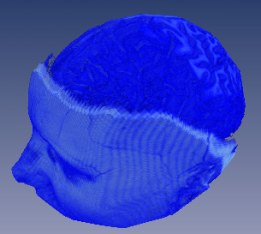
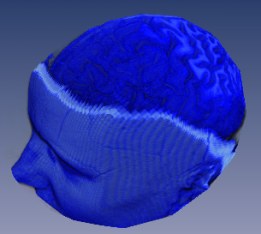
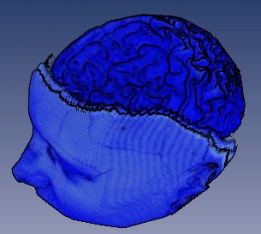
Edge Coloring Faux Shading (see SoTransferFunction)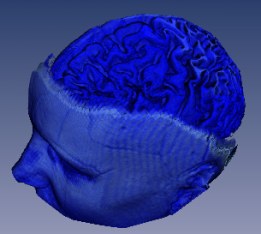
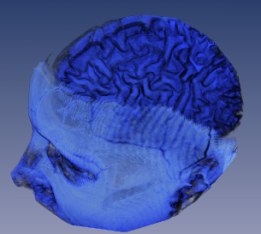
Because this node is derived from
SoVolumeShader, IVVR_FIRST_RESERVED_TEXTURE_UNIT applies to it. SeeSoVolumeShaderfor more information.Volume projection Volume projection (
SoProjectionor derived classes) is incompatible with some options enabled by this node.
Do not enable the preIntegrated, jittering or edgeDetect2D fields when using projection.File format/default:
VolumeRenderingQuality {
lighting false preIntegrated true jittering false gradientThreshold 0.0001 edgeColoring false edgeColor (0, 0, 0) edgeThreshold 0.2 boundaryOpacity false boundaryOpacityIntensity 1.5 boundaryOpacityThreshold 1.5 edgeDetect2D false edgeDetect2DInnerThreshold 0.1 edgeDetect2DOuterThreshold 0.1 edgeDetect2DMethod LUMINANCE gradientQuality MEDIUM colorInterpolation true unnormalizedGradientExponent 0 surfaceScalarExponent 5 segmentedInterpolation false segmentedInterpolationThreshold 0.5 voxelizedRendering false voxelOutline false voxelOutlineThreshold 2. voxelOutlineWidth 2. voxelOutlineColor (0, 0, 0) ambientOcclusion false deferredLighting true interpolateOnMove true Action behavior:
SoGLRenderAction
Sets volume rendering quality parameters in the traversal state.See also:
SoVolumeRender,SoVolumeShader,SoVolumeIsosurface,SoTransferFunction
-
-
Nested Class Summary
Nested Classes Modifier and Type Class and Description static classSoVolumeRenderingQuality.EdgeDetect2DMethodsThe edge detection algorithm used whenedgeDetect2Dis true, can work on the image luminance, depth buffer and/or gradient.static classSoVolumeRenderingQuality.GradientQualitiesGradient Quality mode.static classSoVolumeRenderingQuality.LightingModelsDeprecated.-
Nested classes/interfaces inherited from class com.openinventor.volumeviz.nodes.SoVolumeShader
SoVolumeShader.ShaderPositions
-
Nested classes/interfaces inherited from class com.openinventor.inventor.nodes.SoShaderProgram
SoShaderProgram.GeometryInputTypes, SoShaderProgram.GeometryOutputTypes
-
Nested classes/interfaces inherited from class com.openinventor.inventor.nodes.SoNode
SoNode.RenderModes
-
Nested classes/interfaces inherited from class com.openinventor.inventor.Inventor
Inventor.ConstructorCommand
-
-
Field Summary
Fields Modifier and Type Field and Description SoSFBoolambientOcclusionIf true, apply an ambient occlusion effect (default is false).SoSFBoolboundaryOpacityEnable boundary opacity.SoSFFloatboundaryOpacityIntensityApplies whenboundaryOpacityis true.SoSFFloatboundaryOpacityThresholdApplies whenboundaryOpacityis true.SoSFBoolcolorInterpolationControls interpolation of data values used for color lookup.SoSFBoolcubicInterpolationDeprecated.As of Open Inventor 9300 Use SoVolumeShape.interpolation field instead.SoSFBooldeferredLightingEnable screen space lighting (computed on the GPU).SoSFColoredgeColorColor used to draw edges whenedgeColoringoredgeDetect2Dis true.SoSFBooledgeColoringEnable edge coloring.SoSFBooledgeDetect2DEnable 2D edge detection.SoSFFloatedgeDetect2DInnerThresholdIncrease this value to decrease noise on silhouette edges.SoSFBitMask<SoVolumeRenderingQuality.EdgeDetect2DMethods>edgeDetect2DMethodMethod used for 2D edge detection.SoSFFloatedgeDetect2DOuterThresholdIncrease this value to decrease noise on edges in the volume.SoSFFloatedgeThresholdIf this value is low, more edges will be detected.SoSFEnum<SoVolumeRenderingQuality.GradientQualities>gradientQualitySpecifies the algorithm used to compute gradients, for example, normals for lighting.SoSFFloatgradientThresholdIgnore all gradients with a magnitude less than the specified threshold.SoSFBooljitteringEnable jittering.SoSFBoollightingEnable gradient based lighting (computed on the GPU).SoSFEnum<SoVolumeRenderingQuality.LightingModels>lightingModelDeprecated.As of Open Inventor 10000 No longer used. OPENGL mode is always used.SoSFBoolpreIntegratedEnable pre-integrated volume rendering.SoSFBoolsegmentedInterpolationAllow correct interpolation when rendering segmented data.SoSFFloatsegmentedInterpolationThresholdDefines the iso distance used whensegmentedInterpolationis true.SoSFFloatsurfaceScalarExponentIf this field is greater than or equal to 1, a surface with a small gradient will be less lighted than a surface with a high gradient.SoSFFloatunnormalizedGradientExponentWhen unnormalizedGradientExponent is not 0, surfaces with high gradients will be more lighted than surfaces with small gradients.SoSFBoolvoxelizedRenderingIf true,SoVolumeRenderdisplays voxels as individual cubes.SoSFBoolvoxelOutlineIf true, draw the outline of voxels (default is false).SoSFColorvoxelOutlineColorWhenvoxelOutlineis true, this value specifies the voxel outline color.SoSFFloatvoxelOutlineThresholdWhenvoxelOutlineis true, this threshold specifies the minimum size of a voxel, in screen pixels, for the voxel outline to be visible.SoSFFloatvoxelOutlineWidthWhenvoxelOutlineis true, this value specifies the voxel outline width in pixels.-
Fields inherited from class com.openinventor.volumeviz.nodes.SoVolumeShader
forVolumeOnly, interpolateOnMove
-
Fields inherited from class com.openinventor.inventor.nodes.SoShaderProgram
bufferObjects, generateTransparency, geometryInputType, geometryOutputType, maxGeometryOutputVertices, patchLength, shaderObject, shadowShader, vertexProgramTwoSide
-
Fields inherited from class com.openinventor.inventor.Inventor
VERBOSE_LEVEL, ZeroHandle
-
-
Constructor Summary
Constructors Constructor and Description SoVolumeRenderingQuality()Constructor.
-
Method Summary
-
Methods inherited from class com.openinventor.volumeviz.nodes.SoVolumeShader
isSupported, isSupported
-
Methods inherited from class com.openinventor.inventor.nodes.SoShaderProgram
getFragmentShader, getGeometryShader, getNumReservedTextures, getTessellationControlShader, getTessellationEvaluationShader, getVertexShader, setFragmentShader, setFragmentShader, setGeometryShader, setGeometryShader, setTessellationControlShader, setTessellationControlShader, setTessellationEvaluationShader, setTessellationEvaluationShader, setVertexShader, setVertexShader
-
Methods inherited from class com.openinventor.inventor.nodes.SoNode
affectsState, callback, copy, copy, distribute, doAction, getAlternateRep, getBoundingBox, getByName, getMatrix, getPrimitiveCount, getRenderEngineMode, getRenderUnitID, GLRender, GLRenderBelowPath, GLRenderInPath, GLRenderOffPath, grabEventsCleanup, grabEventsSetup, handleEvent, isBoundingBoxIgnoring, isOverride, pick, rayPick, search, setOverride, touch, write
-
Methods inherited from class com.openinventor.inventor.fields.SoFieldContainer
copyFieldValues, copyFieldValues, enableNotify, fieldsAreEqual, get, getAllFields, getEventIn, getEventOut, getField, getFieldName, hasDefaultValues, isNotifyEnabled, set, setToDefaults
-
Methods inherited from class com.openinventor.inventor.misc.SoBase
dispose, getName, isDisposable, isSynchronizable, setName, setSynchronizable
-
Methods inherited from class com.openinventor.inventor.Inventor
getNativeResourceHandle
-
-
-
-
Field Detail
-
lighting
public final SoSFBool lighting
Enable gradient based lighting (computed on the GPU). Default is false. Gradient based lighting is computed using the direction and magnitude of gradient vectors computed from the data values in place of "normal vectors" in the lighting equation. A gradient vector is computed for each sample point along the rays cast through the volume.VolumeViz also supports screen space lighting (see the
deferredLightingfield).Notes:
- The result of the gradient lighting computation is affected by how the gradient vectors are computed. See the
gradientQualityfield. - Gradient lighting may produce "noisy" results when the gradient magnitudes are small and/or the gradient directions are not consistent. This often happens, for example, in relatively homogeneous regions of a volume. Several fields are provided to compensate for this effect. See
gradientThresholdandsurfaceScalarExponent. - Both gradient lighting and deferred lighting may be enabled at the same time, but the intent is that the application should use one or the other.
- In any case, do not use the
SoVolumeRender.lightingfield.
LIMITATIONS
- Only directional lights (
SoDirectionalLight) are supported. - Only one light source, the first one traversed in the scene graph, is supported.
- The result of the gradient lighting computation is affected by how the gradient vectors are computed. See the
-
preIntegrated
public final SoSFBool preIntegrated
Enable pre-integrated volume rendering.
Pre-integrated rendering can significantly increase image quality (at the cost of slightly lower performance). Default is true.Limitations:
- Pre-integration integrates between color map values. For typical scalar data containing sampled values, this provides a beneficial smoothing. When the color changes sharply between adjacent voxels, it can can cause values that are not actually in the original data to be displayed. This is undesireable for some data, for example "label" volumes resulting from segmentation. Pre-integration is not recommended for such data.
- The
preIntegratedfield has no effect onSoVolumeIsosurfacerendering. - The
preIntegratedfield is only considered when SoVolumeRendering.renderMode is set to VOLUME_RENDERING (the default).
-
jittering
public final SoSFBool jittering
Enable jittering.
If set to true, a random offset is added to texture coordinates in order to decrease ringing artifacts (boundary edge artifacts) without the cost of drawing a higher number of slices. Note that this creates a "noisy" image. Instead we recommend setting theSoVolumeRender.samplingAlignmentfield to BOUNDARY_ALIGNED. Note: Jittering is only available when pre-integrated rendering is enabled. Default is false.
- Since:
- Open Inventor 7.0
-
gradientThreshold
public final SoSFFloat gradientThreshold
Ignore all gradients with a magnitude less than the specified threshold.
Default is 0.0001, meaning that all gradients are used in the lighting computation. Maximum useful value is 1.0, because gradient vectors are normalized. Only affects gradient based lighting (lightingfield).
- Since:
- Open Inventor 7.0
-
edgeColoring
public final SoSFBool edgeColoring
Enable edge coloring.
If true, changes the color based on the gradient direction (normal). Edges will be highlighted with the color specified inedgeColor. Areas where the normal (computed from the gradient) is facing the camera will have an unmodified color, whereas areas where the normal is more perpendicular to the view direction will tend towardsedgeColor. Default is false.
- Since:
- Open Inventor 7.0
-
edgeColor
public final SoSFColor edgeColor
- Since:
- Open Inventor 7.0
-
edgeThreshold
public final SoSFFloat edgeThreshold
If this value is low, more edges will be detected. Default is 0.2. Min value is 0. There is no max, but most of the time a value between 0 and 1 is good.
- Since:
- Open Inventor 7.0
-
boundaryOpacity
public final SoSFBool boundaryOpacity
Enable boundary opacity.
If true, increases boundary opacity based on the gradient magnitude. Default is false.This effect has a significant performance penalty.
SoVolumeRender.subdivideTilewill be disabled if set to true.
- Since:
- Open Inventor 7.0
-
boundaryOpacityIntensity
public final SoSFFloat boundaryOpacityIntensity
Applies whenboundaryOpacityis true. If > 1, this increases the boundary opacity globally. If < 1, decreases it. Default is 1.5.
- Since:
- Open Inventor 7.0
-
boundaryOpacityThreshold
public final SoSFFloat boundaryOpacityThreshold
Applies whenboundaryOpacityis true. If this value is low (near 0), only regions with a high gradient will be enhanced. Default is 1.5.
- Since:
- Open Inventor 7.0
-
edgeDetect2D
public final SoSFBool edgeDetect2D
Enable 2D edge detection.
If this field is true, a 2D edge detection algorithm is used to highlight edges in the rendered image of the volume. Default is false.
- Since:
- Open Inventor 7.0
-
edgeDetect2DInnerThreshold
public final SoSFFloat edgeDetect2DInnerThreshold
Increase this value to decrease noise on silhouette edges. 1 = remove all edges, 0 = remove nothing. Default is 0.1
- Since:
- Open Inventor 7.0
-
edgeDetect2DOuterThreshold
public final SoSFFloat edgeDetect2DOuterThreshold
Increase this value to decrease noise on edges in the volume. 1 = remove all edges, 0 = remove nothing. Default is 0.1
- Since:
- Open Inventor 7.0
-
edgeDetect2DMethod
public final SoSFBitMask<SoVolumeRenderingQuality.EdgeDetect2DMethods> edgeDetect2DMethod
Method used for 2D edge detection.
Specifies the edge detection algorithm used whenedgeDetect2Dis true. Edge detection can work on the image luminance, depth buffer and/or gradient. For example, gradients may be too noisy to give interesting edges and may be ignored with this field. The gradient method is also the slowest (luminance being the fastest) because it needs more texture fetchs. SeeEdgeDetect2DMethod. Default is LUMINANCE and GRADIENT.
- Since:
- Open Inventor 8.1
-
gradientQuality
public final SoSFEnum<SoVolumeRenderingQuality.GradientQualities> gradientQuality
Specifies the algorithm used to compute gradients, for example, normals for lighting. Only affects gradient based lighting (lightingfield).. Default is MEDIUM.
- Since:
- Open Inventor 7.0
-
colorInterpolation
public final SoSFBool colorInterpolation
Controls interpolation of data values used for color lookup.
If false, interpolation is not done on data values used to access the colormap but is still done when computing gradient for lighting. This may be used to render a segmented dataset where interpolation is not appropriate. Default is true. Only affects gradient based lighting (lightingfield).Generally it's better to set the
SoVolumeRender.interpolationfield to NEAREST, unless you really want to use gradient based lighting.- Since:
- Open Inventor 7.2
-
surfaceScalarExponent
public final SoSFFloat surfaceScalarExponent
If this field is greater than or equal to 1, a surface with a small gradient will be less lighted than a surface with a high gradient. The resulting color is a mix between the lighted voxel color and the non-lighted voxel color (ie: the corresponding entry in the colormap). If the value is less than 1, the field is ignored. Values higher than 256 will apply lighting on almost all surfaces. For most datasets, values between 2 and 16 should be enough. Default is 5.
Only affects gradient based lighting (lightingfield).- Since:
- Open Inventor 8.1
-
unnormalizedGradientExponent
public final SoSFFloat unnormalizedGradientExponent
When unnormalizedGradientExponent is not 0, surfaces with high gradients will be more lighted than surfaces with small gradients. Voxels with small gradients will have less diffuse and specular than other with high gradients (ie: ambient color will be the biggest contributor). This lighting contribution can be controlled with this field. If this value is high, smaller gradients will contribute to lighting. Values higher than 256 will apply lighting on almost all surfaces. For most dataset, values between 2 and 16 should be enough. Default is 0.
Only affects gradient based lighting (lightingfield).- Since:
- Open Inventor 8.1
-
segmentedInterpolation
public final SoSFBool segmentedInterpolation
Allow correct interpolation when rendering segmented data. NOTE: Only available onSoVolumeIsosurface.
- Since:
- Open Inventor 8.5
-
segmentedInterpolationThreshold
public final SoSFFloat segmentedInterpolationThreshold
Defines the iso distance used whensegmentedInterpolationis true.
Default is 0.5. value must be in the range [0 .. 1] NOTE: Only available onSoVolumeIsosurface.
- Since:
- Open Inventor 8.6
-
voxelizedRendering
public final SoSFBool voxelizedRendering
If true,SoVolumeRenderdisplays voxels as individual cubes. Default is false.- Since:
- Open Inventor 9.0
-
voxelOutline
public final SoSFBool voxelOutline
If true, draw the outline of voxels (default is false). Notes:- Since Open Inventor 9.6, this mode applies to volume slice primitives (
SoOrthoSliceetc) in addition to volume rendering. - In the case of
SoObliqueSlice, you may see triangles, quadrilaterals and even irregular pentagons in some cases. These lines are correct and correspond to the intersections between the voxels and the oblique slice. For example:
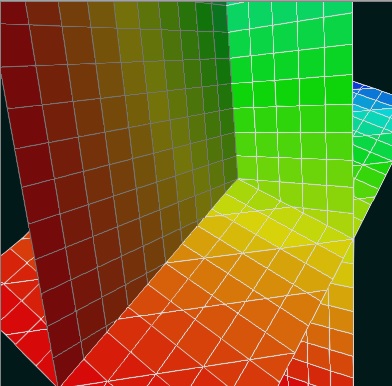
- Since:
- Open Inventor 9.0
- Since Open Inventor 9.6, this mode applies to volume slice primitives (
-
-
voxelOutlineThreshold
public final SoSFFloat voxelOutlineThreshold
WhenvoxelOutlineis true, this threshold specifies the minimum size of a voxel, in screen pixels, for the voxel outline to be visible. Default is 2, meaning that outline is visible only if a single voxel is bigger than 2 screen pixels.- Since:
- Open Inventor 9.2
-
voxelOutlineWidth
public final SoSFFloat voxelOutlineWidth
WhenvoxelOutlineis true, this value specifies the voxel outline width in pixels. Default is 2 pixels.- Since:
- Open Inventor 9.6
-
voxelOutlineColor
public final SoSFColor voxelOutlineColor
WhenvoxelOutlineis true, this value specifies the voxel outline color. Default is black : (0, 0, 0).- Since:
- Open Inventor 9.6
-
ambientOcclusion
public final SoSFBool ambientOcclusion
If true, apply an ambient occlusion effect (default is false). Ambient occlusion is an shading effect that approximates attenuation of light due to neighboring voxels. It works best when the volume data contains surfaces (region boundaries with relatively sharp gradients), or in voxelized rendering mode, and those voxels are opaque.If you use ambientOcclusion, you should set the
SoVolumeRender.samplingAlignmentfield to BOUNDARY_ALIGNED to reduce "slicing" artifacts.NOTE: Only available in raycasting mode.
- Since:
- Open Inventor 9.1
-
deferredLighting
public final SoSFBool deferredLighting
Enable screen space lighting (computed on the GPU). Default is true. Deferred lighting is computed based on the final image depth buffer instead using the data gradients. It is much faster than gradient based lighting (see thelightingfield) and supports multiple light sources (up to 8). Because it is not based on data gradients, it does not have problems with small/random gradients and it gives a much better result when using clipping nodes likeSoVolumeClippingGrouporSoUniformGridClipping. Light sources are defined by Open InventorSoDirectionalLightnodes.Notes:
- Since Open Inventor 9.3, deferred lighting supports up to 8 light sources.
- Both deferred lighting and gradient lighting may be enabled at the same time, but the intent is that the application should use one or the other.
- Gradient related fields, e.g. surfaceScalarExponent, have no effect on deferred lighting.
- In any case, do not use the
SoVolumeRender.lightingfield.
LIMITATIONS
- Only directional lights (
SoDirectionalLight) are supported. - If you use deferredLighting, you should set the
SoVolumeRender.samplingAlignmentfield to BOUNDARY_ALIGNED or SMOOTH_BOUNDARY_ALIGNED to reduce "slicing" artifacts. - The light color is taken into account, but not the light intensity field. You can get the same effect as reduced intensity by reducing the light color values.
- Deferred lighting works best when
- The volume data can be considered to contain "surfaces", for example bones (etc) in medical data or metal parts in NDT data, and
- The transfer function makes the surface material relatively opaque and the surrounding material relatively transparent.
- Since:
- Open Inventor 9.2
-
-
cubicInterpolation
@Deprecated public final SoSFBool cubicInterpolation
Deprecated. As of Open Inventor 9300 Use SoVolumeShape.interpolation field instead.Enable cubic interpolation of data values.
Warning Heavy GPU usage. Primarily useful for still image rendering. Default is false.
- Since:
- Open Inventor 7.0Deprecated since Open Inventor 9300.
UseSoVolumeShape.interpolationfield instead.
-
lightingModel
@Deprecated public final SoSFEnum<SoVolumeRenderingQuality.LightingModels> lightingModel
Deprecated. As of Open Inventor 10000 No longer used. OPENGL mode is always used.Sets the lighting model. For backward compatibility with Open Inventor v6. Applications should set this field to OPENGL. Only affects gradient based lighting (lightingfield).. Default is OIV6.
- Since:
- Open Inventor 7.0Deprecated since Open Inventor 10000.
No longer used. OPENGL mode is always used.